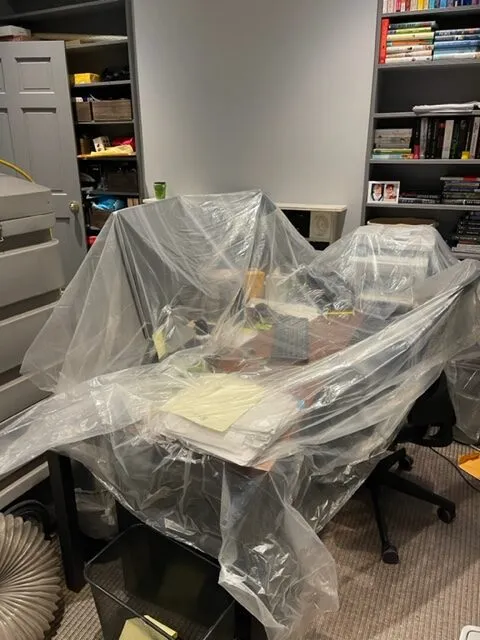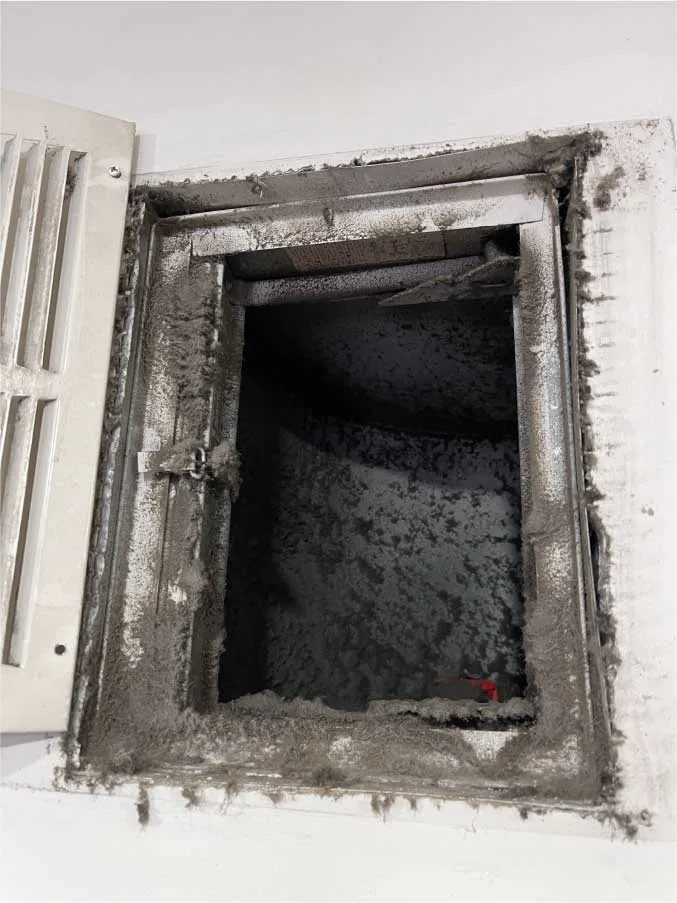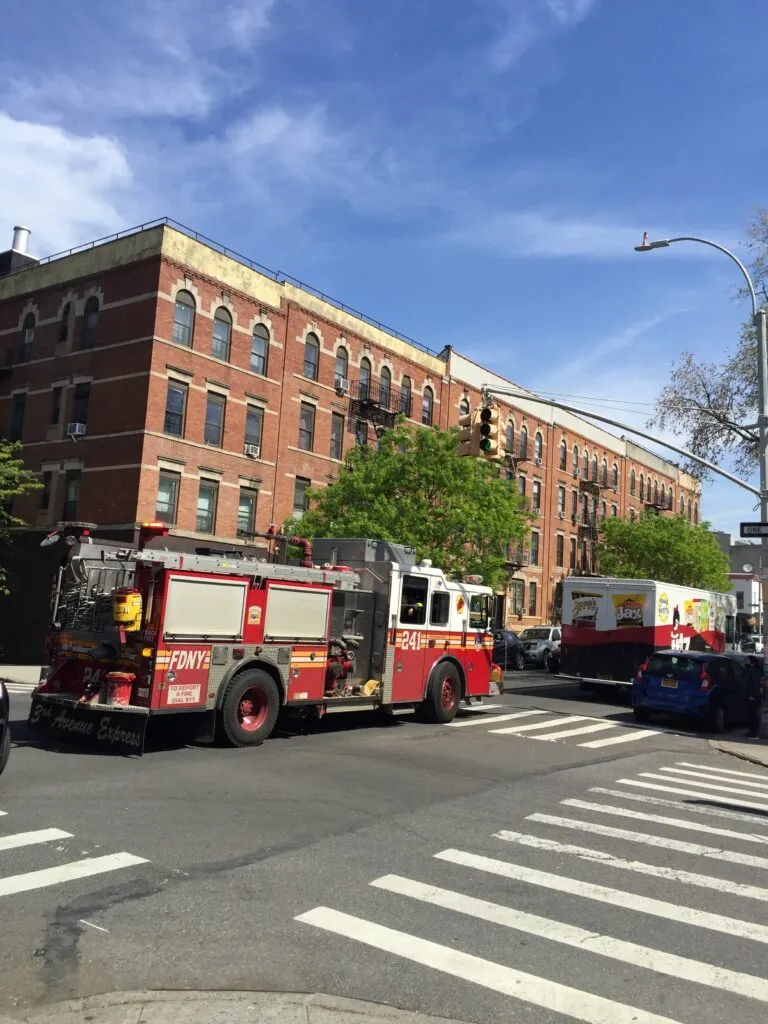Fire Remediation, should it include an Air Duct Cleaning?
Whether it’s a wildfire or a structural fire, cleaning and treating the HVAC system is key to fire remediation. Smoke can infiltrate the HVAC system passively or actively, leaving behind foul odors and the possibility of a soot coating that poses a significant health risk.
The first step to restoring the structure and contents is to remove the source and neutralize the odors.
How Do Passive And Active Smoke Damage Differ?
It is still possible for smoke to get into the HVAC system when it is turned off and not mechanically circulating air. This is passive smoke contamination. Anytime the HVAC system circulates air mechanically, such as on heat or cool settings or simply with the fan on, active smoke contamination is occurring.
Both types of smoke damage to the HVAC system can be treated the same way; however, you need to hire someone qualified to do it.
Why Do You Need Air Duct Cleaning in Fire Remediation?
 Fire Remediation
Fire Remediation
- Soot And Smoke Odors In The HVAC System
Immediately following a fire, it is critical to clean and deodorize the HVAC system so that any soot particles that were caught by the filtration system are removed. To ensure that the vents in the HVAC system are not contaminated with smoke, fire, ash, and soot, all registers and ductwork must be checked for smoke, fire, ash, and soot.
It is a necessary step to restore the proper working condition of the HVAC system by removing soot and smoke odors located throughout the whole system.
- Toxic Chemicals Entering Your Ventilation System
There are some items, such as insulation and furniture that can be very dangerous to your ventilation system, yourself, and your family when they are burned in a structure fire since they contain toxic chemicals.
As these chemicals become airborne, they get into windows and vents. Fires are inherently dangerous, so ventilation systems don’t work for them.
- Smoke Enters The Air Ducts
Air vents transfer smoke between units. You should have the ventilation system cleaned out thoroughly after a fire because smoke can stick to the surface and soak up debris. Airflow through the ducts can also be blocked by smoke. Airflow is blocked by smoke, and fresh air can’t circulate around all the rooms in your house.
A fire prevents an air duct from doing its job when it’s designed to improve ventilation. This needs to be cleaned up as soon as possible. The problem is particularly prevalent in old homes, which are particularly prone to it.
As a first step toward restoring the efficiency of your heating and cooling system, it is essential to remove the smoke smells that are present throughout the system.
Not only is the removal of soot vital to the fire remediation and restoration of the heating and cooling system, but it is crucial to your health and the health of your family as well. During the months that follow, soot will continuously blow out of the vents and into your lungs.
If this continues, it will get onto things like furniture, walls, and clothing. Inhaling airborne soot can worsen health problems or cause them. Electronics can also be damaged by soot.
How Is The HVAC System Cleaned during Fire Remediation?
The cleaning of the HVAC system after a house fire during fire remediation involves the following steps:
- The return ducting needs to be cleaned.
- The air handler needs to be cleaned.
- The supply ducting needs to be cleaned.
Once the HVAC system is thoroughly cleaned, the process of smoke odor elimination starts.
A helpful way to neutralize odors is to oxidize them. In terms of odor-causing molecules, the process of oxidation refers to adding an oxygen atom to them, changing their structure, and making them non-odorous.
Examples of powerful oxidizers include chlorine dioxide and ozone, which are used in odor neutralization.
Neutralizing Ozone Odors
A portable generator produces ozone, which is a pungent, oxidative gas. Located near the return duct opening, the ozone generator is pulled into the duct system by the HVAC system’s blower fan, disinfecting the ducts and air handlers.
As long as the whole structure isn’t treated with an oxidizer yet, this is a good way to get rid of smoke odors in the HVAC system: the ozone will circulate throughout the entire building, treating the structure, the HVAC system, and everything in it.
Neutralizing Chlorine Dioxide Odors
It is possible to mist chlorine dioxide directly onto duct walls and air handlers. An application ball is attached to a pressurized canister called SaniJet, a device that’s pressurized and has a hose attachment.
Through a duct opening, the hose is inserted as far as it can go. The lever on the pressurized canister is depressed. The hose slowly retracts, delivering the ClO2 to the duct walls. SaniJet mists directly on the air handler and its components after the hoses are disconnected.
Traditionally, ClO2 has been applied through HVAC systems by fogging it into the return duct. Then it has been carried through the system by the blower fan of the air handler. However, this method is no longer recommended.
As a result, it is unlikely that any ClO2 will adhere to the walls of the ducts with this method, as little to no ClO2 will adhere and the fog from the supply registers will cover the whole structure in what was intended to be applied to the walls of the ducts.
Why Hire A Professional Air Duct Cleaning Company?
It is common for soot to become trapped in air ducts after a small fire in a building because of the movement of air currents inside the building. Since we all know that heat expands, so when the fire expands, the pressure of the fire can force soot into the duct system even if the unit is not running at the time.
If you don’t treat soot and smoke damage correctly, it’ll get worse. Even though perfumes and KILZ primers attempt to mask odors or remove damage, it’s unlikely they’ll actually help. If you clean your air ducts the wrong way, they can flake off or even change their flame spread ratings over time.
What’s The Cost Of Air Duct Cleaning After A Fire?
If you recently had a house fire, you’re undoubtedly completely swamped with insurance issues, repair requests, and smoke damage cleanup. There is one thing that you may not want to overlook, though: if you have a ducted AC system, you might want to consider having your ducts cleaned.
Many factors go into determining the price of the fire remediation and your ductwork cleaning, when you should order the cleaning, and even how fire damage can influence your decision to order the cleaning.
In addition to fire damage, damage to vents, the type of ducts you have, and more, other factors can affect the cost of air duct cleaning. A full cleaning usually costs between $400 and $1000.
- Level Of Smoke And Fire Damage
Although there are obvious and severe risks associated with house fires, it is the cleanup that will leave you feeling hopeless. Your air ducts will cost more if they’re badly damaged.
- Ductwork Size
The size of the ductwork impacts the price of air duct cleaning during the fire remediation. For instance, which ductwork needs cleaning: that located in a three-story building or that inside an apartment building?
You’ll have to pay based on how big your ductwork is. The cost of air duct cleaning depends on the square footage of your duct system. Multiply the number of ducts in your house by $35 to get an idea of your costs.
- Additional Harm Or Contamination
There may be more work to do after the cleaners clean up the fire and smoke damage. In addition to that, there may be other damage.
Mold is the biggest concern. Moisture and air are all mold needs. Due to the amount of airflow, air duct systems are perfect spots for mold to grow. Your ductwork will cost more if mold is found inside.
- Vermin
Ductwork is a favorite hiding place for mice and rats, as well as other creepy crawlies. Cleaners have a difficult time cleaning them, and their excrement and scratches can damage the ductwork, which means more repairs. Regularly checking your place for vermin will prevent these damages later on.
- Labor
Cleaning companies charge different rates for labor. They’ll charge you based on how big the system is and how much time is required to complete the entire job. Inspection costs are included in labor, so assess the damage yourself before hiring anyone.
- Accessibility
There’s an easy way to design ductwork, like having a dedicated “entrance” for cleaning purposes, and a hard way, like not having easy access points. It will cost you more to clean your ducts if they’re difficult to get to. This is not only because the job is more complicated, but also because it will require a lot more time to accomplish.
House Fire Remediation
The house fire remediation clean-up process includes the following:
Cleanup after a fire involves:
- Take out the debris that has accumulated.
- It is critical to remove any standing water that may be present.
- Repairing water damage as quickly as possible.
- A thorough cleaning of the home and vents is necessary to remove all smoke particles and soot accumulations.
- Contents that have been damaged need to be removed and replaced.
- The goal is to eliminate the smell of smoke and ensure that the home has excellent air quality.
All of these cleanup operations will require a great deal of time, effort, and experience, as well as knowledge of the associated risks to one’s health and safety. Keep in mind that house fire remediation cleanup doesn’t have to be a solo job.
The most challenging and risky elements of the cleanup can be managed and completed by restoration companies with experience and expertise in fire damage, and they can help you at every stage of the fire remediation cleanup.
Common Fire Hazards in the House
In the house, certain fire hazards are more visible than others, and some are simpler to identify. Here is a list of typical home fire hazards, along with advice on how to reduce your risk of being affected by them:
- Cooking Equipment
Cooking with chip pans, frying pans, and grills, which produce and use a lot of oil, can cause them to catch fire easily. Make sure you clean your appliances well after using them and use safer methods, like an oven, where possible.
- Flames and Candles
The problem with candles is that they’re a serious fire hazard. Don’t burn them on flammable objects like curtains or fabrics. Make sure they’re on fireproof surfaces.
- Electric Scooter Charging
Chargers for electric scooters at home are a growing fire hazard. You can reduce the risk by letting the battery cool down before charging, buying from a reputable seller, and unplugging anything after use.
- Electrical Items
Most residential fires start with electric equipment like appliances, wires, and plug sockets.
Unplugging and turning off electrical equipment will keep you safe from a fire. Keep nothing on charge overnight, or if you have to leave it on, don’t leave it in the same room. Disconnect any unused wires from sockets, too.
Chimney Inspections
The risks of fire and carbon monoxide from your fireplace, stove, or furnace can’t be eliminated, but there are things you can do to reduce them. Scheduling routine chimney inspections is the most important thing you can do.
This is why: A professional during chimney inspection will look for creosote accumulation, flue clogs, leakage, cracks, damage, and other concerns that could cost you money or increase your risk of fire or carbon monoxide poisoning.
This means that you’ll be aware of any issues lying down there in your chimney, and you can fix them before you light a fire in your fireplace.
A professional chimney inspection will save you and your family from a horrendous fire accident. In addition, you’ll find out if any repairs are needed before it’s too late. Chimney inspections give you peace of mind and protection. It’s for this reason that they’re so important.
Cleaning Wildfire-Damaged HVAC Systems
An HVAC system can be damaged by a wildfire even if a building doesn’t burn. A well-sealed HVAC system can get clogged with soot – the fine particles carried by smoke and haze. Because it may contain chemicals, metals, acids, and other harmful materials, this particulate can be especially dangerous.
Particulate matter smaller than 10 micrometers is a concern for the EPA since those are tiny enough to get into the lungs through the nose and throat. The particles that makeup soot are as small as 2.5 micrometers, which makes them easier to inhale and well within the EPA’s hazardous range.
As the EPA says, soot is a microscopic particle that can penetrate deep into the lungs and cause some serious health problems, such as premature death, heart attacks, strokes, and acute bronchitis in kids.
Pollution
A large wildfire can produce up to 36 tons of particulate matter a minute, according to studies. As a result of wildfire particulates, HVAC systems can overwork and pose a serious health risk to building occupants. Plus, the fires aren’t going to go away for long.
Fires in the environment last longer, and smoke, soot, and embers are more likely to get into the system. There are a lot of ways soot can get into an HVAC system. Contamination from soot and entry points:
- Connectors for ducts and grilles are incorrectly installed.
- The fire dampers are braced open.
- Cold air ducts or return air ducts.
A system will take ash and smoke from the outside air if it is working properly. If a system is operational, it will draw in smoke and ash from the outside air. Airborne particulates clog up coils, spread throughout the system, and circulate throughout the building.
It doesn’t have to be operational for a system to get dirty with soot, since differential temperatures in occupied spaces mean the HVAC system exchanges air constantly.
Soot can also get into nonfunctional systems:
- An air handler that’s pressurized by outside air.
- Heat recovery ventilators are found in newly built homes.
- HVAC systems that are running in “fan-on” mode.
- The whole house and ceiling fans are working.
Final Thoughts
Whether it’s a wildfire or a structural fire, cleaning and treating the HVAC system is key to fire remediation and smoke restoration. Smoke can infiltrate the HVAC system passively or actively, leaving behind foul odors and the possibility of a soot coating that poses a significant health risk.
When it comes to neutralizing odors, oxidization appears to be the most effective method.
Air duct cleaning after house fires becomes indispensable because soot and smoke enter your HVAC system, toxic chemicals enter your ventilation system, and soot particles make their way to air ducts.
However, if you don’t treat soot and smoke damage correctly, it’ll get worse. If you clean your air ducts the wrong way, they can flake off or even change their flame spread ratings over time.
This necessitates the need to hire a professional air duct cleaning company that can perform their job to the best of their knowledge and expertise.



